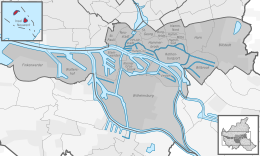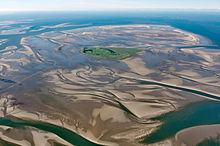geo.wikisort.org - Island
Neuwerk (![]() pronunciation (help·info); (Archaic English: New Werk[1] or Newark[2]) is a 3 km2 (1.2 sq mi) tidal island in the Wadden Sea on the German North Sea coast, with a population[when?] of 32. Neuwerk is located 13 km (8 mi) northwest of Cuxhaven, between the Weser and Elbe estuaries. The distance to the centre of Hamburg is about 120 km (70 mi).
pronunciation (help·info); (Archaic English: New Werk[1] or Newark[2]) is a 3 km2 (1.2 sq mi) tidal island in the Wadden Sea on the German North Sea coast, with a population[when?] of 32. Neuwerk is located 13 km (8 mi) northwest of Cuxhaven, between the Weser and Elbe estuaries. The distance to the centre of Hamburg is about 120 km (70 mi).
 Neuwerk | |
 Location of Neuwerk, Scharhörn and Nigehörn in Hamburg-Mitte | |
 Neuwerk | |
| Geography | |
|---|---|
| Location | North Sea, Elbe mouth |
| Coordinates | 53°55′N 8°30′E |
| Area | 3 km2 (1.2 sq mi) |
| Administration | |
Germany | |
| State | Hamburg |
| Borough | Hamburg-Mitte |
| Demographics | |
| Population | 30 ((2020-12-31)) |
| Pop. density | 13/km2 (34/sq mi) |
Administratively, Neuwerk forms a homonymous quarter of the city and state of Hamburg, Germany, and is part of the borough Hamburg-Mitte. This quarter includes the islands of Scharhörn and Nigehörn, which are bird sanctuaries and closed to the public. All three islands and the Wadden Sea around them form the Hamburg Wadden Sea National Park.
Dikes encircle the island, which is about 3 square kilometres (1.2 square miles), and one can walk around it in an hour. Salt marshes (the "Outland"), lie outside the dikes and provide a hatchery for birds such as oystercatchers, scrays, sandwich terns, black-headed gulls, herring gulls, and others. During the summer farmers may pasture cows and horses on the northern Outland.

At low tide one can reach the island on foot or on a Wattwagen, a horse-drawn mud flat coach, from Cuxhaven. A row of poles on the mud flats marks the way. The path includes some elevated cages. These are rescue pods. Should high tide catch a walker far from shore, the walker can climb into the pod and wait for the tide to recede, or trigger a flare. Triggering the flare summons a rescue boat; rescue involves a fee and non-negligible fine.
During the summer the vessel MS Flipper makes a daily trip at high tide from the "Alte Liebe" port in Cuxhaven to the island. Because departure times depend on the tides, the times are variable. The trip takes about an hour and a half one-way.
One may, for a small fee, visit and ascend the lighthouse to a viewing platform. This provides a view of the coast and the entire island. There is a small hotel with seven guest rooms inside the lighthouse, and a hostel in a building next to the tower. Near the lighthouse there is the "graveyard of the nameless". This is a resting place for the dead bodies that in past years washed ashore. Today, bodies washed ashore are transferred to the continent.
History


Because the Elbe was vital to Hamburg, a member of the Hanseatic League, the city's merchants with those from Bremen and Stade obtained the permission (a deed of 24 April 1286[3]) from Albert II, Duke of Saxony and his minor nephews Albert III, Eric I and John II, altogether co-ruling feudal lords of the Land of Hadeln of which Neuwerk formed a part then, to maintain a permanent fire on a mud flat island, then named O or Nige O, in the mouth of the Elbe.[4]
On 1 November 1299 Albert III and John II allowed the Hamburg and other seafaring merchants to build a fortified tower, named the new work (Neuwerk).[5] Right after work commenced on a 35-metre-high (115 ft) watchtower that could act as a daymark; the tower was completed in 1310.[6] After its completion, an alderman and ten men-at-arms seized the tower. The oldest existing document that mentions Neuwerk is a Frisian contract of 1316. This document uses the island's old name of Nige O.
The current tower dates to 1367, 1369, or 1377 (accounts vary), built after a fire destroyed its wooden predecessor. The tower is Hamburg's oldest existing building as well as the last remainder of Hamburg's fortifications.
In 1648 the tower received a beacon fire that was lit at night. The tower was converted into a lighthouse in 1814. Still, the island was the site of numerous shipwrecks.
During World War I, a shell destroyed the beacon and its signalling apparatus. On 3 September 1915 lightning struck the Zeppelin LZ 40 (L 10), causing it to crash into the North Sea near Neuwerk, with the loss of the entire 20-man crew.
Due to the Greater Hamburg Law Neuwerk became part of Prussia in 1937, and thus after World War II it became part of the new state of Lower Saxony.
In 1946 an 18 kW wind turbine, 15 metres (49 ft) in diameter, installed to economize on diesel fuel, helped power the lighthouse and residences on the island. This installation ran for around 20 years before a submarine cable to the mainland replaced it.[7]
In 1969 Hamburg waived older rights on harbour estate in Cuxhaven in favour of Neuwerk and Scharhörn.[8]
Shipwrecks

| Date | Vessel and description |
|---|---|
| 1 February 1799 | HMS Proserpine stranded in thick ice and snow on the Scharhörn Reef, about 6 miles from Neuwerk. Among the 187 crew and passengers was the British envoy Thomas Grenville, on a diplomatic mission to Berlin via Cuxhaven. Fourteen people died during the escape from the wreck over the Wadden Sea and ice to Neuwerk. In a repeated attempt to retrieve bread from the vessel a few days later a small party of five got trapped aboard the crushed remains of the frigate and floated back to the open sea. Thirty-six hours later Proserpine stranded again near Baltrum Island, where they reached safety again; the wreck remained. |
| 25 November 1817 | Scots Craig was wrecked in the North Sea off Neuwerk with the loss of a crew member. |
| 4 February 1819 | George ran aground off Neuwerk. She was on a voyage from Hamburg to Hull, Yorkshire. (Neuwerk, Schleswig?) |
| 23 July 1820 | Cynthia was driven ashore |
| 5 December 1821 | Ann and/or Manchester was driven ashore and wrecked |
| 10 December 1823 | London was wrecked on Neuwerk. Her crew were rescued. |
| 18 March 1827 | George (Corrna) was lost |
| 22 February 1827 | Apollo and Charlotte ran aground. They were sailing from Sunderland, County Durham, to Hamburg. |
| 9 November 1827 | Egir was stranded between Neuwerk and Duhnen |
| 16 October 1829 | Shubenacadie capsized |
| 18 November 1831 | Union foundered off Neuwerk. Six of her crew were rescued. |
| 16 June 1833 | Frau Christine was driven ashore.[9] |
| 14 December 1932 | Hosianna caught fire and sank in the North Sea off Neuwerk |
Demographics
On 31 December 2007, Neuwerk quarter had 39 inhabitants, 26 female and 13 males. 11 were resident aliens.[10]
Notes
- The New Seaman's Guide, and Coaster's Companion, Cornhill, 1809
- Proserpine Frigate – Official Account of the Loss of that Ship; a letter addressed by Captain Wallis to Vice Admiral Dickson; Feb 18, 1799; "The Naval Chronicle"; January–June 1799; (Bunney & Gold, London); pp. 332–335.
- The deed documented a contract between the Saxon dukes and Bremen's Prince-Archbishop Gilbert of Brunckhorst as to the jurisdiction and taxation over the island today named Neuwerk, which at that time was a seasonal hot spot of herring fishery and sale by merchants from Bremen, Hamburg and Stade, the permission was granted without Hamburg being a contractual party.
- Kurt Ferber, „Der Turm und das Leuchtfeuer auf Neuwerk“, in: Zeitschrift des Vereins für Hamburgische Geschichte, vol. XIV (1909), pp. 1-36, here p. 17.
- Kurt Ferber, „Der Turm und das Leuchtfeuer auf Neuwerk“, in: Zeitschrift des Vereins für Hamburgische Geschichte, vol. XIV (1909), pp. 1-36, here p. 18.
- "Neuwerk Lighthouse". Lighthouse Digest. Retrieved 30 August 2014.
- Dimitri R. Stein, "Pioneer in the North Sea: 1946 Insel Neuwerk Turbine", in IEEE Power and Energy Magazine, September/October 2009, pp. 62-68.
- Law about the agreement with the state Lower Saxony ... [permanent dead link] (in German)
- "Shipping Intelligence". Caledonian Mercury. No. 17469. 29 June 1833.
- Statistische Berichte A I 1 – j/07 H (PDF) (in German), Statistisches Amt für Hamburg und Schleswig-Holstein, 2008-09-11, retrieved 2009-10-31
External links
 Media related to Neuwerk at Wikimedia Commons
Media related to Neuwerk at Wikimedia Commons
На других языках
[de] Neuwerk
Neuwerk [.mw-parser-output .IPA a{text-decoration:none}nɔɪ̯'vɛʁk] ( Anhören?/i; niederdeutsch Neewark) ist eine bewohnte deutsche Insel im südöstlichen Teil der Helgoländer Bucht bzw. am Südwestrand der Außenelbe. Politisch bildet die Insel mit ihren unbewohnten Nachbarinseln Scharhörn und Nigehörn, die 1989 durch Aufschüttung geschaffen wurde[1], den Stadtteil Hamburg-Neuwerk im Bezirk Hamburg-Mitte der Freien und Hansestadt Hamburg, deren Stadtgebiet ca. 120 km Luftlinie in Richtung Ostsüdost entfernt liegt. Sie ist das Zentrum des 1990 gegründeten Nationalparks Hamburgisches Wattenmeer (NPHW), zu dem, neben dem Wattgebiet, auch die beiden Nachbarinseln gehören.[2] Neben der Prägung Neuwerks durch die jahrhundertealten wirtschaftlichen Interessen Hamburgs an einer der meistbefahrenen Schifffahrtsstraßen sind die Insel und das Watt ein maritimer Lebensraum für Flora und Fauna.- [en] Neuwerk
[es] Neuwerk
Neuwerk (?·i) (en bajo alemán Neewark) es una isla alemana que forma parte de las Islas Frisias. Tiene una superficie de unos 3km². Viven unas docenas de personas (33 en 2002).[fr] Neuwerk
Neuwerk.mw-parser-output .prononciation>a{background:url("//upload.wikimedia.org/wikipedia/commons/thumb/8/8a/Loudspeaker.svg/11px-Loudspeaker.svg.png")center left no-repeat;padding-left:15px;font-size:smaller}Écouter est une île allemande de la mer des Wadden en mer du Nord.[it] Neuwerk (isola)
Neuwerk (pron.: /'nɔjvɛʀk/, in lingua basso-tedesca: Neewark; 3 km²[1] 40 ab. circa[1][2][3][4]) è un'isola tedesca sul Wattenmeer (Mare del Nord), situata al largo di Cuxhaven (Bassa Sassonia)[1][2], ma formalmente appartenente al territorio della città-stato di Amburgo[1][2] (da cui dista circa 100 km[1][3]). Dal punto di vista geografico, l'isola fa parte del territorio della Frisia[1] ed è inclusa nel Nationalpark Hamburgisches Wattenmeer[1][2], mentre, dal punto di vista amministrativo, forma - assieme alle isole disabitate di Scharhörn e Nigehörn un quartiere (Stadtteil) del distretto (Bezirk) di Hamburg-Mitte, a cui ha dato il proprio nome[2][4].Другой контент может иметь иную лицензию. Перед использованием материалов сайта WikiSort.org внимательно изучите правила лицензирования конкретных элементов наполнения сайта.
WikiSort.org - проект по пересортировке и дополнению контента Википедии
